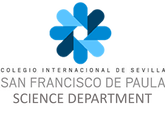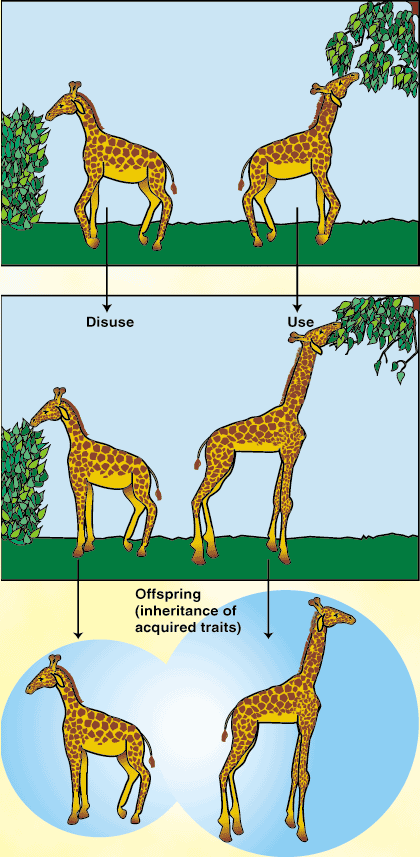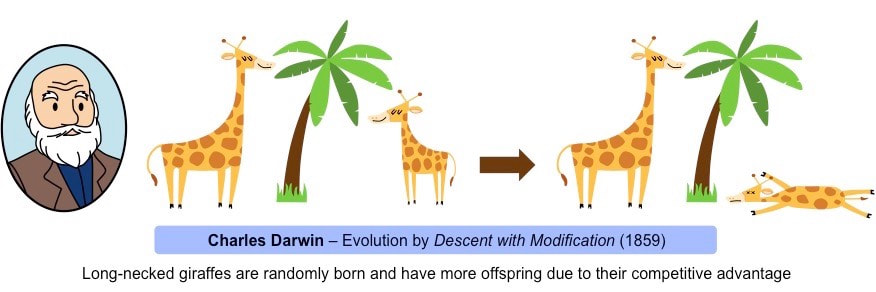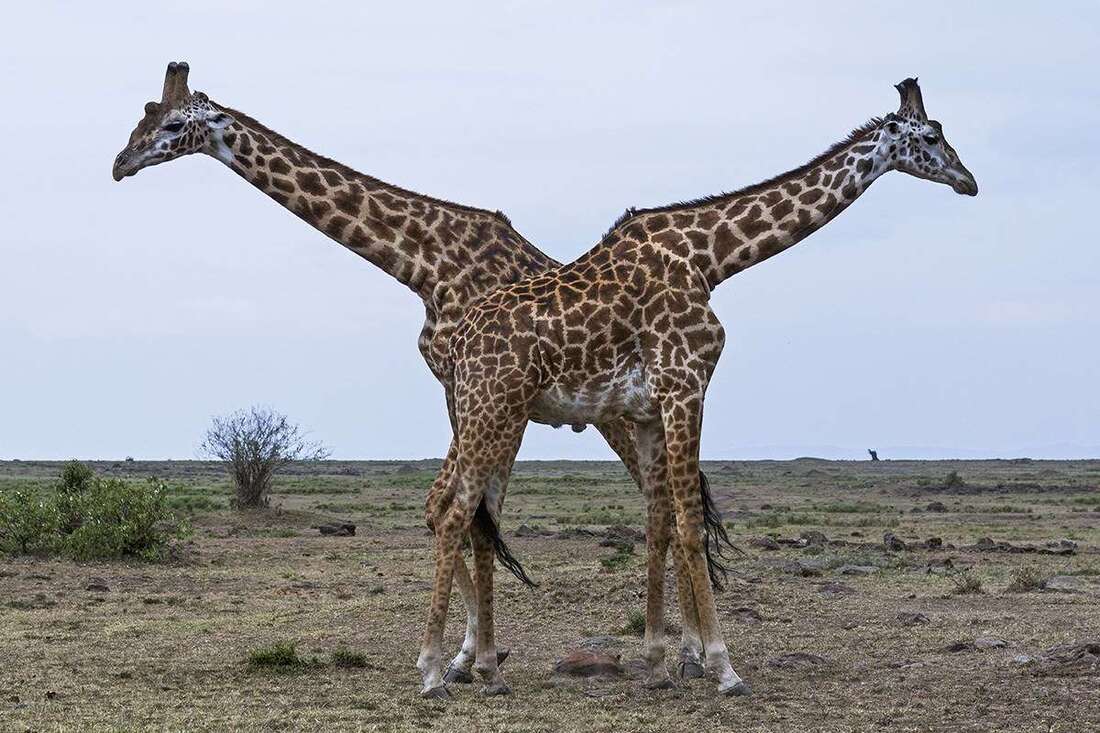Unit 6 - Evolution
Key words
|
|
|
EVOLUTION
Evolution refers to the processes, more or less gradual, that have transformed life on Earth from its earliest forms to the vast diversity that characterizes it today. The first primitive living organisms are dated as far back as 3800 million years ago. In fact everything in the Universe evolves, nothing stays still. We can talk about the evolution of a star, the evolution of the lithosphere… and the evolution of living organisms. It seems obvious that living beings have appeared and disappeared throughout geologic time, and that many species, nowadays with different characteristics, have common ancestors. It is known that there are species that existed in past times and are now extinct, and others which did not exist in older geologic times but that exist today. Generally speaking, evolutionary change is based on the interactions between populations of organisms and their environment. As there have been changes in the environment, different characteristics have been needed in order to adapt to such changes. The different evolution theories study evolution, its history (that is to say the interactions among populations of organisms), and the mechanisms by which life evolves.
Evolution refers to the processes, more or less gradual, that have transformed life on Earth from its earliest forms to the vast diversity that characterizes it today. The first primitive living organisms are dated as far back as 3800 million years ago. In fact everything in the Universe evolves, nothing stays still. We can talk about the evolution of a star, the evolution of the lithosphere… and the evolution of living organisms. It seems obvious that living beings have appeared and disappeared throughout geologic time, and that many species, nowadays with different characteristics, have common ancestors. It is known that there are species that existed in past times and are now extinct, and others which did not exist in older geologic times but that exist today. Generally speaking, evolutionary change is based on the interactions between populations of organisms and their environment. As there have been changes in the environment, different characteristics have been needed in order to adapt to such changes. The different evolution theories study evolution, its history (that is to say the interactions among populations of organisms), and the mechanisms by which life evolves.
|
EVOLUTION THEORIES
1. Lamarck’s Theory of Evolution (1744- 1829) What is his theory based on? 1.Evolution was driven by an innate tendency towards higher and greater complexity, towards perfection. (vital force). 2.This innate tendency to perfection is influenced by environmental changes, therefore becoming better adapted to their environments. These environmental changes would create ‘new needs’ in organisms, needing to use certain organs or characteristics more than others. 3.This use and disuse of certain organs causes those organs that are used more often to cope better with the environment, making them become larger and stronger, while those that are not used deteriorate. In other words: the function makes the organ. So, organisms could acquire certain characteristics throughout its lifetime, and lose others. 4.Lamarck believed that the modifications an organism acquires during its lifetime are passed to its offspring (inheritance of acquired characteristics). 5.One species can not transform into any other species, but only into a similar one where the species can evolve gradually. Lamarck established the fact of evolution, but his theory had several flaws:
|
Acquired characteristics are not inherited. We all know that physical exercise will make our muscles develop, but such acquired physical characteristics (which are not genetic) are not passed down to offspring. Such acquired characteristics are produced by environmental factors and development, but not by genes. Only those characters which are regulated by genes are hereditary, and only if such genes are found in the reproductive cells. Whatever happens to somatic cells due to their use or disuse will not affect the genes in the gametes,
- therefore it will not be hereditary. F.L. August Weissmann (1834-1914) carried out the following experiment to refute Lamarck’s theory: He cut off the tails of fifteen hundred mice, repeatedly over 20 generations, and reporting that no mouse was ever born in consequence without a tail. According to Lamarck and his theory, the disuse of the tail should have given offspring without a tail or with an undeveloped tail, however that was never the case.
2. Darwin’s theory of evolution
Charles Darwin (1809-1882) was born is the West of England (Shrewsbury), in the same year that Lamarck published his theory of Evolution. Darwin was 22 years old when he sailed from England with the Beagle in December 1831; a voyage around the world that would last five years. During the expedition Darwin collected thousands of specimens of the exotic and exceedingly diverse faunas and floras of different places. He was also able to observe the various adaptations of plants and animals that inhabited such diverse environments. After returning from his voyage, Darwin spent almost 20 years analyzing and studying all the data obtained during those five years. Another naturalist, Alfred Wallace who was working in the East Indies, sent a manuscript to Darwin in which he developed a theory of natural selection essentially identical to Darwin’s.
Together, in 1958 they published together their theory on Evolution (it should be called the Darwin-Wallace theory), which replaced Lamarck’s evolutionary theory. Darwin explained his theory in his book The Origin of Species, where he presented his theory of natural selection as the mechanism of evolution. Basically, his theory of natural selection is based on three observations and two conclusions from such observations:
1st Observation: In the absence of environmental pressures (or normal conditions), all species have such great potential fertility that their population size would increase exponentially if all individuals that were born reproduced successfully.
2nd Observation: However, in normal conditions, most populations are stable in size, except for seasonal fluctuations.
1st CONCLUSION: Therefore, not all gametes produced by an individual end up becoming zygotes; not all zygotes become adults; and not all the adults survive and reproduce. So, production of more individuals than the environment can support leads to a struggle for existence among individuals of a population, with only a fraction of offspring surviving each generation.
3rd Observation: Individuals of a population vary extensively in their characteristics. There are not two individuals exactly alike. (Think of your classmates, you each have your particular characteristics, which define you).
2nd CONCLUSION: Survival in the struggle for existence is not random, but depends in part on the hereditary constitution of the surviving individuals. Those individuals whose inherited characteristics fit them best to their environment are likely to leave more offspring than less fit individuals.
A few comments about this theory:
Charles Darwin (1809-1882) was born is the West of England (Shrewsbury), in the same year that Lamarck published his theory of Evolution. Darwin was 22 years old when he sailed from England with the Beagle in December 1831; a voyage around the world that would last five years. During the expedition Darwin collected thousands of specimens of the exotic and exceedingly diverse faunas and floras of different places. He was also able to observe the various adaptations of plants and animals that inhabited such diverse environments. After returning from his voyage, Darwin spent almost 20 years analyzing and studying all the data obtained during those five years. Another naturalist, Alfred Wallace who was working in the East Indies, sent a manuscript to Darwin in which he developed a theory of natural selection essentially identical to Darwin’s.
Together, in 1958 they published together their theory on Evolution (it should be called the Darwin-Wallace theory), which replaced Lamarck’s evolutionary theory. Darwin explained his theory in his book The Origin of Species, where he presented his theory of natural selection as the mechanism of evolution. Basically, his theory of natural selection is based on three observations and two conclusions from such observations:
1st Observation: In the absence of environmental pressures (or normal conditions), all species have such great potential fertility that their population size would increase exponentially if all individuals that were born reproduced successfully.
2nd Observation: However, in normal conditions, most populations are stable in size, except for seasonal fluctuations.
1st CONCLUSION: Therefore, not all gametes produced by an individual end up becoming zygotes; not all zygotes become adults; and not all the adults survive and reproduce. So, production of more individuals than the environment can support leads to a struggle for existence among individuals of a population, with only a fraction of offspring surviving each generation.
3rd Observation: Individuals of a population vary extensively in their characteristics. There are not two individuals exactly alike. (Think of your classmates, you each have your particular characteristics, which define you).
2nd CONCLUSION: Survival in the struggle for existence is not random, but depends in part on the hereditary constitution of the surviving individuals. Those individuals whose inherited characteristics fit them best to their environment are likely to leave more offspring than less fit individuals.
A few comments about this theory:
- According to Darwin, evolution is gradual, slow and continuous: there are no sudden or brusque changes. It is a gradual accumulation of minute changes.
- Environmental factors are what drive natural selection. With time, those individuals with characteristics less fit to their environment would disappear, and those with favourable variations would be perpetuated. (Survival of the fittest).
- Over vast spans of time, and always due to environmental factors, a group of individuals could accumulate a considerable amount of favourable characteristics giving rise to a new species from the original population.
- Still nowadays, many people mistakenly believe that it is Darwinism that explains evolution. There are many objections to the Darwinian view, (many of those objections were presented whilst he was still alive).
- When Darwin had to explain what caused individual variations among organisms of a population he had to borrow Lamarck’s acquired characteristics theory (Weissman will not carry out his experiments until 1880). Mendel enunciated the laws of heredity six years after Darwin published his book, however Mendel’s work was not recognized or appreciated until 30 years later, which considerably slowed down the understanding of evolutionary mechanisms.
- Another objection: if natural selection only preserves or eliminates what already existed, how can it create new species? As we will see, natural selection does create new species.
TODAY’S THEORY OF EVOLUTION
(The modern evolutionary synthesis or neo-Darwinism)
A comprehensive theory of evolution that became known as the modern synthesis or neo-Darwinism was forged in the earlies 1940s. This theory is not the work of one but many scientists. It is called the synthesis because it integrated discoveries and ideas from many different fields, including population genetics, paleontology, taxonomy, etc)
It brings together Charles Darwin's theory of the evolution of species by natural selection with Gregor Mendel's theory of genetics as the basis for biological inheritance. Major figures in the development of the modern synthesis include Ronald Fisher, Theodosius Dobzhansky, J.B.S. Haldane, Sewall Wright, Julian Huxley, Ernst Mayr, George Gaylord Simpson and G. Ledyard Stebbins.
We can define evolution as the natural selection (which is seen through differential reproduction), that acts upon genetic variations (which are the outcome of mutations or sexual recombination) which appear among the members of a population.
Some important aspects of this definition are:
Evolution of the giraffe according to the modern evolutionary synthesis:
The ancestors of today’s giraffes did not have a long neck nor long front legs. By mutation and/or genetic recombination new individuals presenting a long neck and/or long legs appeared in a population. Those new individuals were better adapted to the environment. They ate more, found mating partners more easily and therefore reproduced more often. With time they became the only existing giraffes. Obviously the individuals that presented the short neck and short legs (both negative characteristics), as they were less well adapted to the environment, they did not reproduce as successfully as the well-adapted giraffes. And eventually the less favorable genes disappeared from the population.
(The modern evolutionary synthesis or neo-Darwinism)
A comprehensive theory of evolution that became known as the modern synthesis or neo-Darwinism was forged in the earlies 1940s. This theory is not the work of one but many scientists. It is called the synthesis because it integrated discoveries and ideas from many different fields, including population genetics, paleontology, taxonomy, etc)
It brings together Charles Darwin's theory of the evolution of species by natural selection with Gregor Mendel's theory of genetics as the basis for biological inheritance. Major figures in the development of the modern synthesis include Ronald Fisher, Theodosius Dobzhansky, J.B.S. Haldane, Sewall Wright, Julian Huxley, Ernst Mayr, George Gaylord Simpson and G. Ledyard Stebbins.
We can define evolution as the natural selection (which is seen through differential reproduction), that acts upon genetic variations (which are the outcome of mutations or sexual recombination) which appear among the members of a population.
Some important aspects of this definition are:
- A population is a localized group of individuals belonging to the same species, where the individuals interbreed amongst themselves, and occasionally, with members of other populations.
- As a result of this closed sexual interaction in a population, a gene flow is created (that is to say that the genes of the different individuals circulate within the population, and could be transmitted to the entire population).
- The genetic variations among individuals could be due to: mutations (this variations can take place in individuals with both types of reproduction, asexual and sexual); and meiotic or sexual recombination (this takes place during meiosis I, therefore, it can only happen in individuals with sexual reproduction).
- Because of mutations and meiotic recombinations, individuals with new characteristics are constantly born. If those individuals survive and have offspring, their new characteristics will stay within the gene pool or group of genes of the population. In successive generations those genetic variations could be passed down to many (or all) members of the population.
- Whether that would happen or not depends on natural selection (some individuals have more offspring than others). Those organisms best adapted to a given environment will be most likely to survive to reproductive age and have offspring of their own. Organisms that are successful in their environments will be more likely to be successful in reproduction, and therefore the better-adapted organisms will reproduce at a greater rate than the less well-adapted organisms. Therefore, the genes of the ones that reproduce more will predominate in the gene pool of the population. This is known as differential reproduction
- It is important to understand that it is just how well adapted they are, but how well they are able to reproduce, in order to be able to pass down the new characters. (Though they usually go hand and hand). For example, it could be that an individual is very well adapted to its environment, however, it has a mutation that makes it sterile. Would this individual have any impact in the evolution of its population?
- The process of evolution has therefore two stages: first of all genetic variation must occur due to mutations and/or meiotic recombinations; and second, those variations must spread throughout the population by differential reproduction (natural selection) in successive generations.
- Individuals do not evolve, populations do. The genetic characteristics that an individual has usually don’t vary throughout its life and once it dies they disappear. However, if the individual reproduces sexually, it could introduce genetic variations to its offspring.
- The process of evolution does not follow a fixed pattern, as genetic variations happen randomly. This does not mean that evolution lacks a driving force: as the individuals that are most successful in reproduction are those that are best adapted, the driving force of evolution is natural selection.
- Therefore, natural selections acts by means of differential reproduction, and not by the struggle for survival.
Evolution of the giraffe according to the modern evolutionary synthesis:
The ancestors of today’s giraffes did not have a long neck nor long front legs. By mutation and/or genetic recombination new individuals presenting a long neck and/or long legs appeared in a population. Those new individuals were better adapted to the environment. They ate more, found mating partners more easily and therefore reproduced more often. With time they became the only existing giraffes. Obviously the individuals that presented the short neck and short legs (both negative characteristics), as they were less well adapted to the environment, they did not reproduce as successfully as the well-adapted giraffes. And eventually the less favorable genes disappeared from the population.





